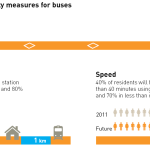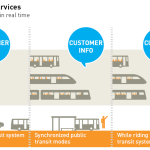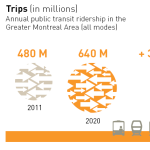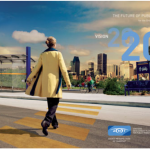What will tomorrow’s public transit network look like? What are
the leading issues and requirements that must be addressed by
the transit network in order to attract users and compete against
cars? The main challenges facing the AMT (Agence métropolitaine
de transport) are outlined in its strategic development plan
for public transit: The Future of Public Transit for the Greater
Montreal Area ‒ Vision 2020.
The AMT is a government agency whose mission is to expand
public transit services in order to improve commuting efficiency
in the Greater Montreal area. It plays a regional planning and
transit funding role in a territory covering 4,000 km2, 83 municipalities,
14 transit organizations and 12 para-transit [[Para-transit are public services provided to people with disabilities and older people]] agencies.
Against the backdrop of this complex governance structure,
the AMT has been mandated to produce a 10-year strategic
development plan for metropolitan transit including commuter
trains as well as bus and metro services.
The 2020 Plan was made public in November 2011. It encompasses
three strategic objectives for the development of mass
transit in the region, along with several large-scale projects and
numerous initiatives that target overall improvements in service
quality. The plan calls for nearly $17bn to be invested over a 10
year time frame:
- $2.4bn for the metropolitan bus network;
- $10.3bn for the metro and other guided transport systems;
- $3.7bn for commuter rail;
- $400M for service quality improvement initiatives targeting
all modes of transportation.
Consulting our partners and citizens
The AMT has involved its partners and clientele, as well as interested
citizens, in defining strategic directions for improving public transit
in the region. During two discussion forums, the partners
developed a shared vision of the main public transit issues and
priorities that need to be addressed. In addition, AMT customers
and other citizens of Montreal were asked to voice their
expectations during two rounds of consultations: one online and
another involving public meetings. This participatory approach
helped identify the major issues involved in improving public
transit in the region, which are:
- Adapting to changing transportation and mobility requirements:
renewed popularity of public transit; increasing
number of trips between suburbs; need to travel outside of
peak hours or in the counter-peak direction;
- Managing demographic and urban growth: strong population
growth in outlying areas typically characterized by low
residential density, more widely dispersed activities and
growing car ownership;
- Improving the quality of service offered to customers: need
to improve route time performance, make trips throughout the metropolitan network easier and more seamless, and
add capacity to the network so as to increase service levels.
Service improvements based on customer needs
In response to these issues, the AMT developed a metropolitan public
transit vision for 2020 designed to facilitate mobility in the region and
improve the quality of life of its residents. The overall goal is to make
public transit services even faster and more frequent, as well as
convenient, user friendly, accessible and diversified. Three strategic
objectives were identified to help turn this vision into reality.
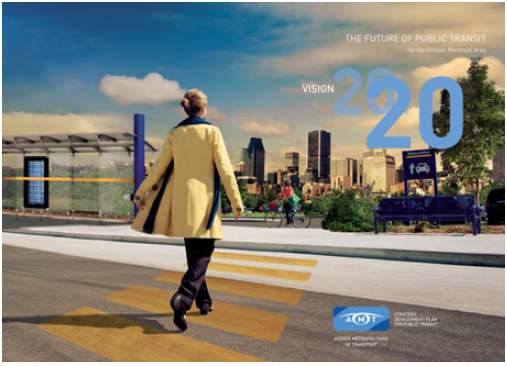
Objective 1: Easier trips
The AMT wants to make travel on its network easier for customers
by adopting four action principles:
- Facilitate access to terminals, train stations and metro stations
by prioritizing sustainable modes of transportation (walking,
biking and public transit); - Improve coordination between transit modes and carriers in the
region in order to make customer trips as seamless as possible; - Provide clear and detailed real-time information throughout the
network so that customers can better plan their trips and
make adjustments in the event of any service disruptions; - Simplify and integrate fare payment practices throughout the
metropolitan area
Objective 2: Better quality of life
Public transit can play a key role in improving the quality of life of
residents in the Montreal area and it is therefore necessary to
maximize its contribution to sustainable development. Several actions
have been planned with this in mind:
- Design sustainable facilities that integrate harmoniously with
the existing environment and anticipate future mobility needs; - Create quality living environments by supporting urban planning
strategies that are integrated with public transit plans and by
developing certain strategic sites; - Improve the network’s energy performance by extending
electrification to the bus and commuter train networks.
Accordingly, the AMT is emphasizing the use of hydroelectric
power, of which Quebec is the world’s fourth leading producer.
Objective 3: A rapid, multi-modal metropolitan transit
network
Customers appreciate fast and frequent transit services that offer an
effective alternative to the automobile. A rapid, high-frequency
multi-modal metropolitan transit network is therefore required to
meet these expectations. Large-scale projects and quality improvement
initiatives have been planned for each mode of transportation:
- Metro: Extend three of the four existing metro lines; add
system capacity to increase service levels by acquiring new
rolling stock and planning rapid transit links for some major
transportation corridors (for example, by adding light rail
transit, or LRT); - Commuter trains: Improve service quality in the existing
network by installing passenger-dedicated tracks, creating
express trains and enhancing service in the counter-peak
direction and during off-peak hours; - Metropolitan bus network: Improve its performance by
completing the reserved bus lane network, by increasing
the use of preferential measures and by implementing bus
rapid transit (BRT) services.
Ambitious but realistic targets
Progress and performance with respect to the 2020 Plan will be
measured based on three types of targets: seamlessness of customer
trips in the network; increased use of sustainable mobility in the
network; and deployment of the metropolitan network.
By 2020, customer trips throughout the network will be faster, easier
and more seamless.

By 2020, public transit users will be more numerous and more likely
to use active and public forms of transportation to get to their station.

By 2020, a larger percentage of the region’s population will have
access to a rapid public transit service within reasonable distance of
their homes.

For more information contact Mélanie Nadeau
The 2020 Plan is available in PDF format at: http://plan2020.amt.qc.ca/Home
